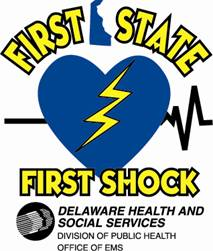Delaware Early Defibrillation Program: AED Corner

Welcome to “The AED Corner”, the official website of the Delaware Early Defibrillation Program. This website is managed by the State of Delaware Department of Health and Social Services, Division of Public Health, Office of Emergency Medical Services and is not only intended to serve as a guide to prospective agencies in becoming an integral part of the Delaware Early Defibrillation Program, but is also intended to serve as an information clearinghouse for current Delaware Early Defibrillation Program agencies, including police, fire and rescue agencies. This site contains helpful links and information relative to current program status, updates, notices, manufacturer warnings, Federal Food and Drug Administration warnings and any other information pertinent to the Delaware Early Defibrillation Program and semi-automatic external defibrillators.
PROGRAM HISTORY
Automatic external defibrillators (AEDs) and semi-automatic external defibrillators (SAEDs) first made their debut in Delaware in the 1993-1994 timeframe with the introduction of the First Medic 510 model defibrillator. The defibrillator itself looked like a heavy, bulky military ammunition box. However at that time, it was state-of-the-art equipment. The target user for this model was fire company ambulances and rescue trucks. The units were purchased by fire and rescue companies; hence the precursor to what is now known as the Delaware Early Defibrillation Program. In 1998-1999, Delaware became a recipient of a portion of tobacco company litigation funding. Under the leadership of the State Office of Emergency Medical Services Director, came the birth of what is was known as the Delaware Early Defibrillation Program, also known as The First State, First Shock Program. The Director knew the positive impact AEDs had in cases of sudden cardiac arrest and wanted a true Public Access Defibrillation (PAD) program to reduce morbidity and mortality by sudden cardiac arrest in Delaware. Through the wise leadership of Delaware Legislators, funding was granted using tobacco monies to purchase and distribute AEDs, at no cost, to agencies/companies both private and public throughout Delaware.
CURRENT PROGRAM STATUS
Under the leadership of the Director of the Office of Emergency Medical Services and through continued funding, the Delaware Early Defibrillation Program continues to combat death and disability by sudden cardiac arrest. Funding for the program is used to purchase AEDs and provide initial CPR/AED training to agencies applying for an AED through the program. Agencies meeting the criteria to receive an AED apply by filling out the proper registration forms. Priority is determined using the Public Access Defibrillation Study results. Currently there are over 3300 defibrillators in our database purchased through tobacco funding that have been distributed throughout Delaware. This does not take into account the number of units that have been purchased and placed in service through private funds.
The Office of Emergency Medical Services will continue to promote the Delaware Early Defibrillation Program to reduce morbidity and mortality from sudden cardiac arrest.
MORE INFORMATION
For more information, please contact the program office.
USEFUL LINKS
- American Heart Association
- Emergency Care and Safety Institute
- American Red Cross
- National Safety Council
- Health and Safety Institute
- Pacific Medical Training
![]() Please note: Some of the files available on this page are in Adobe PDF format which requires Adobe Acrobat Reader. A free copy of Adobe Acrobat Reader can be downloaded directly from Adobe . If you are using an assistive technology unable to read Adobe PDF, please either view the corresponding text only version (if available) or visit Adobe’s Accessibility Tools page.
Please note: Some of the files available on this page are in Adobe PDF format which requires Adobe Acrobat Reader. A free copy of Adobe Acrobat Reader can be downloaded directly from Adobe . If you are using an assistive technology unable to read Adobe PDF, please either view the corresponding text only version (if available) or visit Adobe’s Accessibility Tools page.



